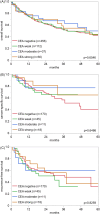CEA (CEACAM5) expression is common in muscle-invasive urothelial carcinoma of the bladder but unrelated to the disease course
- PMID: 38873357
- PMCID: PMC11168773
- DOI: 10.1002/bco2.354
CEA (CEACAM5) expression is common in muscle-invasive urothelial carcinoma of the bladder but unrelated to the disease course
Erratum in
-
Erratum.BJUI Compass. 2024 Dec 30;5(12):1324-1329. doi: 10.1002/bco2.482. eCollection 2024 Dec. BJUI Compass. 2024. PMID: 39744071 Free PMC article.
Abstract
Objectives: Carcinoembryonic antigen (CEA) is a cell surface glycoprotein that represents a promising therapeutic target. Serum measurement of shedded CEA can be utilized for monitoring of cancer patients.
Material and methods: To evaluate the potential clinical significance of CEA expression in urothelial bladder neoplasms, CEA was analysed by immunohistochemistry in more than 2500 urothelial bladder carcinomas in a tissue microarray format.
Results: CEA staining was largely absent in normal urothelial cells but was observed in 30.4% of urothelial bladder carcinomas including 406 (16.7%) with weak, 140 (5.8%) with moderate, and 192 (7.9%) with strong staining. CEA positivity occurred in 10.9% of 411 pTaG2 low-grade, 32.0% of 178 pTaG2 high-grade, and 43.0% of 93 pTaG3 tumours (p < 0.0001). In 1335 pT2-4 carcinomas, CEA positivity (34.1%) was lower than in pTaG3 tumours. Within pT2-4 carcinomas, CEA staining was unrelated to pT, pN, grade, L-status, V-status, overall survival, recurrence free survival, and cancer specific survival (p > 0.25).
Conclusion: CEA increases markedly with grade progression in pTa tumours, and expression occurs in a significant fraction of pT2-4 urothelial bladder carcinomas. The high rate of CEA positivity in pT2-4 carcinomas offers the opportunity of using CEA serum measurement for monitoring the clinical course of these cancers. Moreover, CEA positive urothelial carcinomas are candidates for a treatment by targeted anti-CEA drugs.
Keywords: CEA; CEACAM5; bladder cancer; immunohistochemistry; prognosis; tissue microarray.
© 2024 The Authors. BJUI Compass published by John Wiley & Sons Ltd on behalf of BJU International Company.
Conflict of interest statement
The rabbit recombinant CEA antibody, clone MSVA‐465R was obtained from MS Validated Antibodies GmbH, Hamburg, Germany (owned by a family member of GS).
Figures


References
LinkOut - more resources
Full Text Sources
